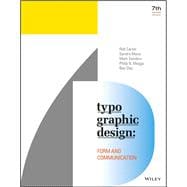The bestselling introduction to designing the written word
Typographic Design: Form & Communication is the definitive reference for graphic designers, providing a comprehensive introduction to the visual word. Done well, typopgraphy can communicate so much more than the words themselves. Typographic design determines how you feel about a message, the associations you make, and ultimately, the overall success of the communication. Typographic design extends from the page to the screen, and is a critical element of almost any graphic design project. This book provides essential guidance on everything related to type: from letterforms and negative space, to messaging, processes, and history, aspiring designers will find great utility in mastering these critical concepts.
This new seventh edition has been fully updated with new coverage of contemporary typography processes, updated case studies, and new examples from branding, print, web, motion, and more. On-screen typographic design concepts are discussed in greater detail, and the online supplemental materials include new flashcards, terminology and quizzes.
- Understand design factors as they relate to type
- Explore communication and typographic messaging
- Learn how typography has evolved, and where it is headed
- Adopt established approaches to designing with type
The irony of typographic design is that, when done well, it often goes unnoticed—but its impact on a project’s overall success is undeniable. Typography can make or break a page, can enhance or overpower an image, and can obscure a message or bring it into sharp focus. It is one of the most powerful tools in the graphic designer’s arsenal, and Typographic Design is the complete, practical introduction.









